
Can Dogs Eat Sushi?
of reading - words
Sushi has become a popular delicacy worldwide, appreciated for its unique flavors and health benefits. As a dog owner, you may wonder if this human treat is safe to share with your furry friend. The short answer is that while some types of sushi can be safe for dogs in moderation, others can pose significant risks. Understanding the ingredients and potential hazards is essential before offering sushi to your dog.
In this comprehensive guide, we’ll explore whether dogs can eat sushi, the benefits and risks involved, and how to ensure your dog’s safety.
What Is Sushi?
Sushi is a traditional Japanese dish typically made with rice, seaweed, fish, and various toppings or fillings. It comes in many forms, including:
-
Nigiri: Sliced fish or seafood placed on a small mound of rice.
-
Maki: Rolled sushi made with rice, seaweed, and fillings like fish or vegetables.
-
Sashimi: Slices of raw fish served without rice.
-
Temaki: Hand-rolled sushi in a cone shape.
Each type of sushi contains different ingredients, some of which may be suitable for dogs, while others are not.
Can Dogs Eat Sushi? The Safe and Unsafe Ingredients
Whether sushi is safe for dogs depends on its ingredients. Let’s break down the common components:
1. Fish
Fish is a primary ingredient in sushi, and certain types can be safe for dogs:
-
Safe Fish: Cooked salmon, cooked tuna, and other non-toxic fish in small amounts can provide protein and omega-3 fatty acids, which are beneficial for a dog’s coat and skin.
-
Unsafe Fish: Raw fish, especially types high in mercury like mackerel or swordfish, can be harmful. Raw fish may also contain parasites like tapeworms or bacteria that can lead to food poisoning.
2. Rice
Rice is generally safe for dogs. It is easily digestible and can be a good source of energy. However, sushi rice often contains vinegar, sugar, and salt, which are not ideal for dogs in large quantities.
3. Seaweed
Nori, the seaweed used in sushi, is safe for dogs in moderation. It contains essential nutrients like iodine and vitamins. Avoid processed or seasoned seaweed, as it may contain salt or spices harmful to dogs.
4. Vegetables
Many vegetables used in sushi, such as cucumber and carrots, are safe for dogs. However, avoid ingredients like avocado, which contains persin, a substance toxic to dogs.
5. Soy Sauce
Soy sauce is a common accompaniment to sushi, but it is unsafe for dogs due to its high salt content. Excessive salt can lead to dehydration and sodium poisoning.
6. Wasabi and Pickled Ginger
Both wasabi and pickled ginger should be avoided. Wasabi can cause gastrointestinal upset, and pickled ginger often contains sugar and vinegar, which are not ideal for dogs.
Benefits of Sushi for Dogs
When prepared safely, sushi can offer some nutritional benefits for dogs:
-
Protein: Fish provides a high-quality protein source.
-
Omega-3 Fatty Acids: These help maintain a healthy coat and reduce inflammation.
-
Vitamins and Minerals: Seaweed and vegetables offer essential nutrients like iodine, vitamin A, and potassium.
Risks of Feeding Sushi to Dogs
Despite its potential benefits, feeding sushi to dogs comes with risks:
1. Parasites in Raw Fish Raw fish can carry parasites like tapeworms and roundworms, which can cause severe health problems if ingested.
2. Mercury Poisoning Certain fish, such as tuna, contain high levels of mercury. Overconsumption can lead to mercury poisoning, causing neurological issues.
3. Allergic Reactions Some dogs may be allergic to fish or other sushi ingredients, leading to symptoms like itching, vomiting, or diarrhea.
4. Gastrointestinal Upset Ingredients like soy sauce, wasabi, and pickled ginger can irritate your dog’s stomach, leading to vomiting or diarrhea.
5. Choking Hazards The small size and texture of sushi rolls can pose a choking risk, especially for smaller dogs.
How to Safely Feed Sushi to Dogs
If you decide to share sushi with your dog, follow these guidelines to ensure their safety:
1. Avoid Raw Fish Only offer cooked fish to prevent the risk of parasites and bacterial infections.
2. Skip Harmful Ingredients Remove any soy sauce, wasabi, pickled ginger, or avocado from the sushi.
3. Use Plain Rice Offer plain, unseasoned rice instead of sushi rice, which often contains vinegar and sugar.
4. Offer in Moderation Sushi should be an occasional treat and not a regular part of your dog’s diet.
5. Monitor for Allergic Reactions If your dog tries sushi for the first time, observe them for any signs of an allergic reaction.
Dog-Friendly Sushi Recipe
Here’s a simple and safe sushi recipe you can prepare for your dog:
Ingredients:
-
Cooked salmon or chicken
-
Plain rice
-
Nori (seaweed)
-
Dog-safe vegetables like cucumber or carrot
Instructions:
-
Spread the cooked rice evenly over a sheet of nori.
-
Add small pieces of cooked salmon or chicken and vegetables.
-
Roll the nori tightly and cut it into bite-sized pieces.
-
Serve in moderation as a treat.
Frequently Asked Questions (FAQ)
1. Can dogs eat raw fish in sushi? No, raw fish can contain parasites and bacteria that may harm your dog. Always opt for cooked fish.
2. Is seaweed safe for dogs? Yes, plain nori used in sushi is safe for dogs in small amounts. Avoid processed or seasoned seaweed.
3. Can dogs eat avocado in sushi? No, avocado contains persin, which is toxic to dogs and can cause vomiting and diarrhea.
4. How much sushi can I give my dog? Sushi should be given as an occasional treat in small amounts to avoid overfeeding and potential health issues.
5. What should I do if my dog eats harmful sushi ingredients? If your dog consumes ingredients like wasabi, soy sauce, or raw fish, monitor them closely for signs of distress and contact your veterinarian if needed.
Conclusion
While some types of sushi can be safe for dogs, it’s essential to be cautious about the ingredients and preparation methods. Avoid raw fish, harmful seasonings, and toxic ingredients like avocado. If you want to treat your dog to sushi, consider preparing a homemade version with dog-safe ingredients. Always prioritize your dog’s health and consult your veterinarian if you’re unsure about introducing new foods to their diet.




